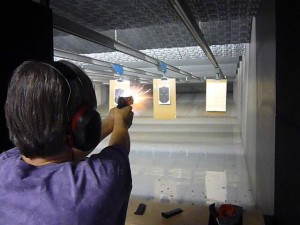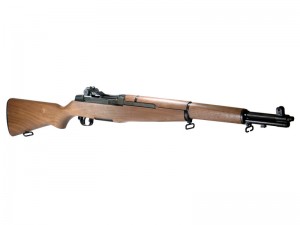
When I was 12 I finally convinced my mom to let me get into paintball and buy a few paintball guns. Although they differ greatly from a real gun, I quickly went to work figuring out their internal similarities and comparing parts in the paintball guns to their firearm counterparts. I found that they had a breech and a barrel like any gun should. They had a moving bolt like a rifle. They even had an electronic firing pin, which would strike a release valve, triggering the air charge that would fire the paintball. It was fascinating.
Around 15 years old I convinced my mom to get me get my first airsoft pistol. It was a cheap little thing from Dick’s sporting goods but now I had a gun which appeared quite realistic to the layman and fired a projectile with a great deal of short-range accuracy. Over the next year I bought a few more of these cheap spring pistols before finally upgrading to a gas airsoft pistol. This thing was ‘the shit’ at the time. Every single facet of the replica functioned just like its real life counterpart. You loaded pellets into the magazine, which was weighted like a real, loaded magazine. You inserted the mag in the gun and racked the slide. There was a functional single or double-action hammer stage. When fired, the gun would cycle the slide with a gas charge, loading the next pellet. This would then continue until the last shot was fired, at which point the slide would lock back and you could change mags. I was hooked. I began studying shooting techniques and doing speed and accuracy drills and became pretty good at my shooting fundamentals before every firing a real gun.

I got another stab at shooting when I was 17 and in the Poconos with my family. My dad and I went to an outdoor range where I used an Ak-47, an M4A1, .44 Magnum Desert Eagle, Beretta M9, HK USP, Remington M700 sniper, and an M24 sniper. I didn’t get to shoot many rounds with each gun, but the additional diversity broadened my firearm horizons. When I was 18 I went up to Manchester Firing Line with my close friend Alex. I was at this point extremely well versed with shooting techniques and theory from my extensive research and conceptual practice with my airsoft replicas (of which I then had many). We started with a few different Glocks, since I have an airsoft Glock 23. This was the first time I’d been shooting where there was no close supervision. They hand you and gun and a box of ammo in a basket, you walk into the range, and go to it.
As I suspected I would, I absolutely loved loading bullets into a magazine. With every bullet pushed into the mag it felt like I was building potential energy, just waiting, wanting to be converted to ballistic, kinetic energy. We started with a Glock 17, one of the most well known and well performing pistols in the world. This was my first time using a real Glock and I loved it from the first shot. Alex was extremely surprised by the recoil of a firearm and had no idea what was to come. We then moved to the compact version of the 9mm Glock 17, the Glock 19. This felt familiar in my hand since I have an airsoft replica of the same size. I was more accurate with the smaller model and found it more controllable since I could fully envelope it in my hands. The Glock 23 was next, a .40 S&W version of the 19. This immediately became my favorite pistol and still holds that title. From my extensive research I knew the .40 was a superior caliber to both the 9mm and .45, providing the stopping power of the .45 with the penetration of the 9mm. Most people report that the .40 has a recoil that is too snappy and hard to control. There is some truth to this but something about the Glock 23 makes it controllable. Next we stepped up to a .45 Ruger pistol which was cool for diversity’s sake but not that interesting. We then grabbed an M4 which turned out to be one of the more memorable guns I’ve fired. The M4 jammed on its first shot. Through all of my research I knew what to do and unjammed it. It jammed again. This happened three times and I finally brought it out to the range master to look at it. He unjammed it and handed it back. I went into the range, loaded it, and fired one shot at our small target 60ft away. It jammed again. We walked out, handed the rifle back, got a refund and grabbed the HK MP5K and two boxes of 9mm bullets. As I was loading the first magazine, Alex retracted the target. “Dude!”, he exclaimed. “What”, I responded as I continued loading. “Look!”, he said. I looked up and the one round that I had launched from the M4 had gone dead through the center of the bullseye. I still have the target today.
Now I loaded the MP5K and unfolded the collapsible stock. This was to be my first time behind an automatic weapon. I started with semi-auto to get a feel for the gun and it generated more recoil than I expected. I switched it to 3-round burst and quickly realized why automatic fire is generally impractical. My shots were spraying all over the place but it was definitely a rush to shoot. I ended up trying a few 4 and 5 round bursts on automatic and did this throughout two whole mags. The last gun we tried was a 12-gauge Remington 870 with deer slugs. Having used one before, I cautioned Alex that if he braced it improperly he would bruise his shoulder or break his collarbone. He had just finished loading the gun and when I said that he looked up and said, “Why don’t you shoot first!” When I first the first shot, I heard Alex yell, “HOLY SHIT.” It was a little more powerful than he knew it would be. 4 rounds each later, we had run out of money and I had, in my book, concluded my days of being an amateur shooter. In concept I was fairly experienced, and in practice I was at least intermediate.
My next outing to Manchester Firing Line Range would prove that I know my way around guns at this point and have graduated from Novice to Intermediate.
